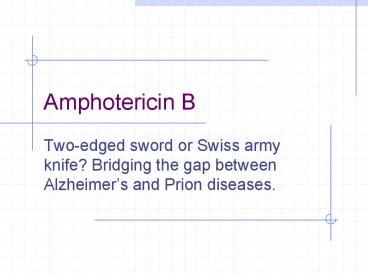Amphotericin B - PowerPoint PPT Presentation
Title:
Amphotericin B
Description:
Amphotericin B Two-edged sword or Swiss army knife? Bridging the gap between Alzheimer s and Prion diseases. What are some Amyloid Diseases? Alzheimer s disease ... – PowerPoint PPT presentation
Number of Views:55
Avg rating:3.0/5.0
Title: Amphotericin B
1
Amphotericin B
- Two-edged sword or Swiss army knife? Bridging the
gap between Alzheimers and Prion diseases.
2
What are some Amyloid Diseases?
- Alzheimers disease
- Atrial Amyloidosis
- Hereditary Renal Amyloidosis
- Secondary Systematic Amyloidosis
- Injection-Localized Amyloidosis
3
What are some Prion Diseases?
- Chronic Wasting Disease (CWD)
- Scrapie
- BSE- Mad Cow Disease
- Kuru
- Creutzfeldt-Jakob Disease
4
Amyloids vs Prions
- Prions are known to be infectious in their
spreading to different hosts, e.g. CWD, BSE,
kuru, etc - Amyloid diseases - not thought to be infectious
agents but.
5
Amyloids vs. Prions-news!
- It has been recently shown that mice who were fed
amyloid fibrils (from the spleen of infected
mice) orally (in H2O) developed amyloid deposits
upon stimulation.
6
Amyloids vs. Prions, pt. II
- Similar propagation of fibrils in vitro.
- Similar symptoms (inflammatory neuropathies) and
adverse affects from having the disease.
7
These diseases involve fibril deposits What is a
fibril?
- Normal PrP or Ab protein may misfold into a beta
sheet structure - The beta sheets form extended aggregate fiber
structures by recruiting properly folded
proteins - These fibrils are protease resistant and
insoluble - This is the most prevalent characteristic of
amyloid and prion diseases.
- Prion Protein-PrP
8
Alzheimers Disease Amyloid hypothesis
9
Possible approaches to treating Amyloid and Prion
Diseases.
- 1. Physical blockage of fibril growth (by small
molecules). - 2. Alter processing/clearance of protein (enzyme
inhibitors) - 3. Damage Control of existing fibrils(?) (NSAIDs
-- Non-steroidal Anti- Inflammatory Drugs,
Statins) - 4.Symptomatic (anticholinergics)
- 5. Effecting an immune response.
- Specific-vaccine
- Non-Specific-general stimulant
10
How would Physical Blockage work?
- Congo Red a molecule that binds to and inhibits
fibril growth. - Congo Red is an azo dye that was used by Alois
Alzheimer to characterize brains with Alzheimers
disease - Some other in vitro success using N-methylated
peptides, anti-sense peptides and other small
molecules.
11
AD model system 1 Characterizing fibrils
- Congo Red binds to fibrils very specifically.
- Absorbance at 540 nm can be used to quantitate
fibril formation - The Insulin Fibril system was used as it is a
proven amyloid model system.
12
Hypothesis
- AmB is one of the only agents known to slow prion
diseases in animal models (hamster,mouse)! - Perhaps AmB could act by the 1st mechanism by
binding to existing fibrils and preventing
growth, thus preventing the propagation of the
disease.
13
Why AmB?
- Amphotericin B is an antifungal drug used to
treat immuno-compromised people (AIDS, cancer)
who have deep fungal infections. - Amphotericin B is also an interesting molecule
that has a polyene side and a polyol side, which
may hint to its binding characteristics. - It is also a relatively inexpensive drug that is
already on the market.
14
Does AmB bind to fibrils?
- Yes it does!
- Although the actual binding site(s) are unknown,
it does bind to fibrils specifically and not to
protein in native form. - 1 mole AmB/2 mole insulin
- Kd1.1µM
15
Does AmB B inhibit insulin Fibril Formation?
- No it doesnt.
- Luckily it does not induce fibrils either
- Thus, AmB neither inhibits nor promotes fibril
formation under these conditions (pH 2-HCl).
16
AD model system 2 AD APP-fragment 25-35
GSNKGAIIGLM
17
Ab 25-35
- Minimal Alzheimers unit?
- Rapidly fibrillizes(1 hr)
- Can promote protein denaturation-anti chaperone
- Is cytotoxic and neurotoxic likeAb????????????????
????????? - Our titration of the Ab25-35 fibrils with Congo
Red shows 1 fibril peptide per Congo Red.
18
Ab 25-35 fibrils do bind AmB
19
Butdoes AmB B inhibit Ab 25-35 Fibril Formation?
20
Butdoes AmB B inhibit Ab 25-35 Fibril Formation?
- Yes it does!! At reasonable therapeutic
concentrations, too (7.5 and 15µM) - However, it only delays the onset of
fibrillogenesisit does not change final
concentration - Ab 1-40 and PrP peptides will be the real test.
21
How else might Amphotericin B work in addition to
fibril inhibition?
- Amphotericin B may work non-specifically. Because
of its properties and known prior use, it may be
able to activate the generalized immune system
acute phase response (IL-1, IL-6) and promote
removal of amyloid or prion deposits. Fibrils
may also help sequester AmB in tissues most
strongly affected. - Previous reports have shown that introducing AmB
2 weeks prior or immediately with the systematic
prion inoculum effectively slows the course of
the prion infection. Later treatment is less
effective. - It might bind to and modify oligomer ion channel
properties associated with amyloid diseases. - AmB would selectively associate with
cholesterol-rich membrane rafts and alter
processing (Ab) or conversion(PrP). - Vaccination analog, i.e. could AmB-protein adduct
resemble a fibril and lead to antibody/T-cell
response?(But.. SCID mice.)
22
Conclusions
- Amphotericin B binds specifically to two
different b?????? fibril models suggesting a
possible mechanism for its demonstrated
antiprion activity. - This is further supported by the kinetic
inhibition of Ab 25-35 fibrillization by AmB and
suggests a possible screening assay for future
potential drugs - Further testing on PrP and Ab?????2???????????????
???????????????????????? confirm this?hypothesis - As a sidelight, it seems worth investigating
whether the fungal amyloid-like protein
hydrophobin may be important to AmB
susceptibility/resistance
23
THANKS !
- Ted Weiland
- Emily Bauer and Evan Kwong
- NSF for
- Rachel Nauss
24
Projects in our lab
- Physical characterization of Amphotericin B drug
delivery vehicles (stability, ion channel
formation) - Pharmaceutical testing of new AmB preparations
(with K. Wasan) - Cytokine expression profiles caused by AmB preps
in immune cells (with L. Turtinen) - Localization and metabolism of liposomal
doxorubicin in single cells (with E. Arriaga) - AmB potential effects on amyloid diseases































